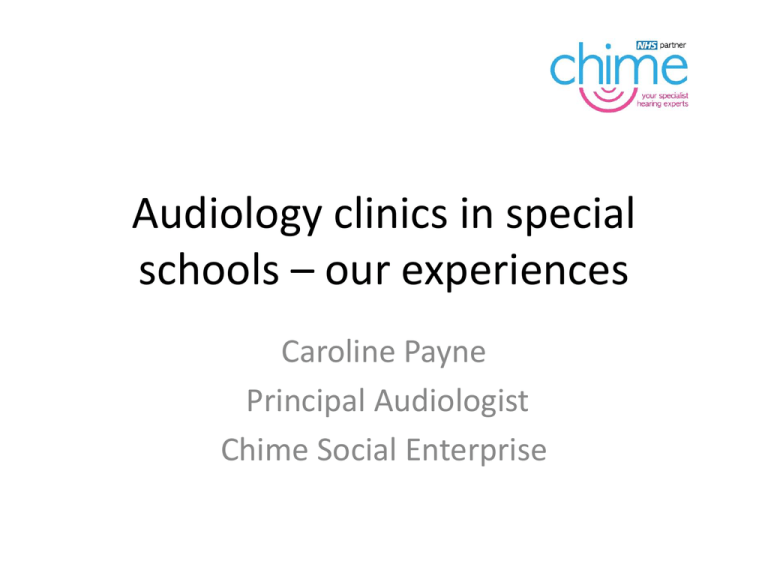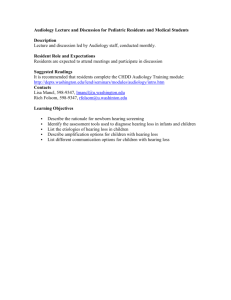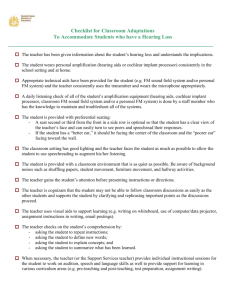File
advertisement

Audiology clinics in special schools – our experiences Caroline Payne Principal Audiologist Chime Social Enterprise Historical perspective • Audiology in this area (Exeter, Mid and East Devon) has run clinics in local special schools for many years in order to provide the school entry hearing screen. • Historically these clinics were run jointly with Advisory Teachers for HI children however as their role has changed and their caseloads increased this has stopped. • More recently it has become obvious there is a gap in provision for children with hearing loss in these schools and less awareness of the importance of hearing well within the classroom. Case study - Sarah • Sarah had hearing tested as a baby via the NICU which indicated NCR bilaterally for OAE with satisfactory click ABR results, discharged at that stage • Re-referred aged 2 ½ as part of a wider assessment of her complex needs which include ASD and developmental delay. Repeat ABR indicated borderline thresholds for high frequencies, again discharged • Subsequent hearing tests were attempted at school although Sarah did not engage well in the early years finding the tests distressing Sarah (cont) • Age 10 results consistently indicated a moderate high frequency hearing loss but there were no parental or school concerns and hearing aids were not considered an option as it was felt Sarah would be distressed by them • Annual review until age 12 when parents reported noticing hearing difficulties (Sarah was making more progress with language at this stage). Hearing aids fitted – initially open life tips due to tactile defensiveness • Sarah has tolerated the hearing aids well from the beginning , choosing to wear both , now uses conventional earmoulds and has even tolerated real ear measurement Case Study- James • James has CHARGE syndrome and a complex medical history. Initial ABR indicated a hearing loss for the left ear but he was not followed up at that stage • At age 2, concerns were raised about lack of vocalisation and behavioural testing indicated overall moderately raised thresholds in the presence of middle ear congestion; parents were not concerned about hearing. James was referred to ENT but subsequently did not attend • At age 6, he was re referred, behavioural testing proved difficult. Grommets were subsequently inserted in Bristol. Subsequent appointments with audiology were not attended • At age 10, James was seen at school for testing which indicated significantly raised levels for McCormick toy test, he was unable to concentrate for PTA although bone conduction appeared significantly better than overall levels James (cont) • Discussed a softband baha with parents which was subsequently fitted and gave noticeable benefit • Consistent use was difficult to establish with lost and faulty devices but support was given by his class teacher and consistent use established in that environment • Due to comfort issues implantation was considered at age 12 years. School and parents were given information to help support James through the process. PTA at that stage indicated a bilateral mixed hearing loss ranging from severely raised thresholds in the low frequencies to mild/ moderate in the high frequencies • James now has an implanted abutment, he still needs to be encouraged to use the aid consistently. He will report if the battery is flat. Aided thresholds are good. His behaviour at school is noted to deteriorate when not using the aid Case study- David • David required resuscitation at birth and initial OAE testing although meeting clear response criteria indicated no responses in the highest frequency band. Subsequent behavioural testing confirmed a severe high frequency hearing loss above 3 kHz • Parents were reluctant to trial hearing aids. Hearing was monitored and hearing aids fitted when inclarities in speech became apparent and a trial was requested by SLT. It took a couple of years to establish consistent use at school, but aids were not worn at home (David has some tactile sensitivity) • Consistent use maintained at mainstream primary school with support from Advisory HI teacher David(cont) • On transfer to special school (age 9 years) hearing aids were not worn. An audiology visit found staff not aware of the hearing loss or hearing aids although these had been sent in by home. There was no support from Advisory HI Teacher. Attendance by the family at audiology appointments at the hospital was also poor at this stage • 18 months later consistent use of hearing aids has again been established at school. Aided thresholds across the speech frequency range are good and aided McCormick Toy testing indicates 100% at quiet voice levels Improving the Service • Concerns were raised at the local CHSWG • Information shared via CHSWG of learning in other areas • Involvement of our local Paediatrician in dialogue with special schools and in attending a clinic • Identified changes to current practice which could be readily implemented What we are doing differently • Routinely inviting parents to attend their child’s appointment at school • Where parents are unable to attend asking for information regarding any concerns they have about their child’s hearing • Using Individual Management Plans to inform parents and school of outcomes • Identifying a lead teacher within the school to ensure staff are informed of and engaged with the process • Working to try and involve the Advisory Teacher’s in attending clinics with us Going forwards • Plan to replicate changes across all special schools in our area. Need to identify a lead teacher at each school. • Need for clarity around what support the Advisory Teachers for HI children are able to offer in this area. Dialogue with managers/ commissioners? Via Devon strategic CHSWG? • Investigate the need for provision of training for staff at special schools around listening/ hearing impairment. Introduce some of the learning from Somerset study?







